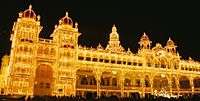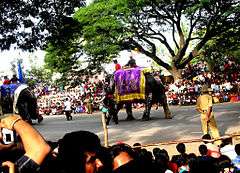Vijayadashami
Vijayadashami (IAST: Vijayadaśamī, pronounced [ʋɪʝəjəðəʃmɪ]]) also known as Dussehra, Dasara or Dashain is a major Hindu festival celebrated at the end of Navaratri every year. It is observed on the tenth day in the Hindu calendar month of Ashvin or Kartik, the sixth and seventh month of the Hindu Luni-Solar Calendar respectively, which typically falls in the Gregorian months of September and October.[4][5][6]
| Vijayadashami | |
|---|---|
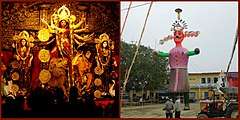 Vijayadasami reveres either Durga's or Rama's victory over evil depending on the region.[1] | |
| Also called | Dashehra, Dasara, Navaratri |
| Observed by | Hindus |
| Type | Religious, Cultural |
| Significance | Celebrates the victory of good over evil |
| Celebrations | Marks the end of Durga Puja or Ramlila |
| Observances | pandals (stages), plays, community gathering, recitation of scriptures, puja,fasting, immersion of Durga or burning of Ravana |
| Date | Ashvin (September or October) |
| 2020 date | 25 October (Sun)[2] |
| 2021 date | 15 October (Fri)[3] |
Vijayadashami is observed for different reasons and celebrated differently in various parts of the Indian subcontinent.[7][1][8][4] In the southern, eastern, northeastern, and some northern states of India, Vijayadashami marks the end of Durga Puja, remembering goddess Durga's victory over the buffalo demon Mahishasura to restore and protect dharma.[4][9] In the northern, central and western states, the festival is synonymously called Dussehra (also spelled Dasara, Dashahara). In these regions, it marks the end of "Ramlila" and remembers God Rama's victory over the Ravan. On the very same occasion, Arjuna alone decimated more than 1,000,000 soldiers and defeated all Kuru warriors including Bhishma, Drona, Ashwatthama, Karna and Kripa, a significant example of victory of good (Dharma) over evil (Adharma). Alternatively, it marks a reverence for one of the aspects of goddess Devi, such as Durga or Saraswati.[1][5][6]
Vijayadashami celebrations include processions to a river or ocean front that involve carrying clay statues of Durga, Lakshmi, Saraswati, Ganesha and Kartikeya, accompanied by music and chants, after which the images are immersed in the water for dissolution and farewell. Elsewhere, on Dasara, towering effigies of Ravan, symbolising evil, are burnt with fireworks, marking evil's destruction. The festival also starts the preparations for Diwali, the important festival of lights, which is celebrated twenty days after Vijayadashami.[10][11][1]
Etymology
Vijayadashami (Devanagari: विजयदशमी ) (Kannada: ವಿಜಯದಶಮಿ) (Tamil: விஜயதசமி) (Telugu: విజయదశమి) is a composite of two words "Vijaya" (विजय) and "Dashami" (दशमी), which respectively mean "victory"[12] and "tenth,"[13] connoting the festival on the tenth day celebrating the victory of good over evil.[1][8] The same Hindu festival-related term, however, takes different forms in different regions of India and Nepal, as well as among Hindu minorities found elsewhere.[14]
According to James Lochtefeld, the word Dussehra (Devanagari: दशहरा) (Kannada: ದಸರಾ ಹಬ್ಬ) is a variant of Dashahara which is a compound Sanskrit word composed of "dasham"(दशम) and "ahar" (अहर), respectively meaning "10" and "day".[15][16][17]
Ramayana
Ravana kidnapped Sita. Rama requested Ravana to release her, but Ravana refused; the situation escalated and led to the war. After performing severe penance for ten thousand years, Ravana received a boon from the creator-god Brahma: he could henceforth not be killed by gods, demons, or spirits. He is portrayed as a powerful demon king who disturbs the penances of rishis. Lord Vishnu incarnates as the human Rama to defeat and kill him, thus circumventing the boon given by Lord Brahma. A deadly and fierceful battle takes place between Rama and Ravana in which Rama kills Ravana and ends the evil rule. Ravana has ten heads. The killing of the one who has ten heads is called Dusshera. Finally, Dharma was established on the Earth because of Rama's victory over Ravana. Thus, this festival is celebrated reminding the victory of Good over Evil.
Mahabharata
In the Mahabharata, the Pandavas are known to have spent their thirteenth year of exile in disguise in the kingdom of Virata. Before going to Virata, they are known to have hung their celestial weapons in a Shami tree for safekeeping for a year.[18][19] Bhima kills Kichaka. Hearing about the death of Kichaka, Duryodhana surmises that the Pandavas were hiding in Matsya. A host of Kaurava warriors attacks Virata, presumably to steal their cattle, but in reality, desiring to pierce the Pandavas' veil of anonymity. Full of bravado, Virata's son Uttara attempts to take on the army by himself while the rest of the Matsya army has been lured away to fight Susharma and the Trigartas. As suggested by Draupadi, Uttar takes Brihannala with him, as his charioteer. When he sees the Kaurava army, Uttara loses his nerve and attempts to flee. Then Arjuna reveals his identity and those of his brothers'. Arjuna takes Uttar to the tree where the Pandavas hid their weapons. Arjuna picks up his Gandiva after worshipping the tree, as the Shami tree safeguarded the Pandavas’ weapons for that complete year. Arjuna reties the thread of Gandiva, simply drags and releases it - which produces a terrible twang. At the same point of time, Kaurava warriors were eagerly waiting to spot Pandavas. Dispute talks took place between Karna and Drona. Karna told Duryodhana that he would easily defeat Arjuna and does not feel threatened by Drona's words since Drona was intentionally praising Arjuna, as Arjuna was the favourite student of Drona. Ashwathama supports his father by praising Arjuna. Then Arjuna arrives to the battlefield.[20] Eager to defend the land that had given him refuge, Arjuna engaged the legion of Kaurava warriors. The battle starts between Arjuna and the entire Kuru army. All the warriors including Bhishma, Drona, Karna, Kripa and Ashwathama together attacked Arjuna to kill him, but Arjuna defeated all of them multiple times simultaneously.[21] During the battle, Arjuna also killed Sangramjita, the foster brother of Karna, and instead of taking revenge for his brother, Karna fled in order to save his life from Arjuna. Karna tried to fly away from Arjuna but he could not since Arjuna invoked Sammohanaastra which made the entire army fall asleep.[22] This is the war in which Arjuna proved that he was the best warrior in the world at his times. In this way, Arjuna alone defeated the entire Kuru army consisting of 1,000,000s of soldiers; Duryodhana, Dushyasana, Shakuni and Maharathis : Bhishma, Drona, Karna, Kripa and Ashwatthama. One of the names of Arjuna is Vijaya - ever victorious. This incident took place on the same day in which Lord Rama killed Ravana. As it was Arjuna's day, the day also became popular as "Vijaya Dashami"
Regional variations
Northern India
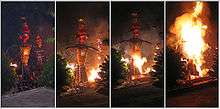
In most of northern and western India, Dasha-Hara (literally, "ten days") is celebrated in honour of Raam Thousands of drama-dance-music plays based on the Ramayan and Ramcharitmanas (Ramlila) are performed at outdoor fairs across the land and in temporarily built staging grounds featuring effigies of the demons Ravan, Kumbhakarna and Meghanada. The effigies are burnt on bonfires in the evening of Vijayadashami-Dussehra.[6] While Dussehra is observed on the same day across India, the festivities leading to it vary. In many places, the "Rama Lila", or the brief version of the story of Rama, Sita and Lakshaman, is enacted over the 9 days before it, but in some cities such as Varanasi the entire story is freely acted out by performance-artists before the public every evening for a month.[23]
The performance arts tradition during the Dussehra festival was inscribed by UNESCO as one of the "Intangible Cultural Heritage of Humanity" in 2008.[24] The festivities, states UNESCO, include songs, narration, recital and dialogue based on the Hindu text Ramacharitmanas by Tulsidas. It is celebrated across northern India for dussehra, but particularly in historically important Hindu cities of Ayodhya, Varanasi, Vrindavan, Almora, Satna and Madhubani.[24] The festival and dramatic enactment of the virtues versus vices filled story is organised by communities in hundreds of small villages and towns, attracting a mix of audiences from different social, gender and economic backgrounds. In many parts of India, the audience and villagers join in and participate spontaneously, some helping the artists, others helping with stage setup, make-up, effigies and lights.[24] These arts come to a close on the night of Dussehra, when the victory of Raam is celebrated by burning the effigies of evil, Ravan and his colleagues.[25]
Himachal Pradesh
Kullu Dussehra is celebrated in the Kullu valley of Himachal Pradesh and is regionally notable for its large fair and parade witnessed by estimated half a million people. The festival is a symbol of victory of good over evil by Raghu Nath, and is celebrated like elsewhere in the Indian subcontinent with a procession.[26] The special feature of the Kullu Dasara procession is the arrival of floats containing deities from different parts of the nearby regions and their journey to Kullu.[27]
Southern India
Vijayadasami is celebrated in a variety of ways in South India.[28] Celebrations range from worshipping Durga, lighting up temples and major forts such as at Mysore, to displaying colorful figurines, known as a golu.
The festival played a historical role in the 14th-century Vijayanagara Empire, where it was called Mahanavami. The Italian traveller Niccolò de' Conti described the festival's intensity and importance as a grandeur religious and martial event with royal support. The event revered Durga as the warrior goddess (some texts refer to her as Chamundeshwari). The celebrations hosted athletic competitions, singing and dancing, fireworks, a pageantry military parade and charitable giving to the public.[29][30]
The city of Mysore has traditionally been a major center of Dasara-Vijayadashami celebrations.[29]
Another significant and notable tradition of several South Indian regions has been the dedication of this festival to Saraswati, the Hindu goddess of knowledge, learning, music and arts. She is worshipped, along with instruments of one's trade during this festival. In South India, people maintain, clean and worship their instruments, tools of work and implements of their livelihood during this festival, remembering Goddess Saraswati and Durga.[25]
Kids aged 3–4, who are new to school, are admitted to school on Vijayadasami Day.[31]
Western India
- Maharashtra -In Maharashtra this festival is called as Dasara.[32] The deities installed on the first day of Navratri are immersed in water. Observers visit each other and exchange sweets.[33]
_Vijaya_Dashami_The_art_work_India_October_2013.jpg)
The festival has been historically important in Maharashtra. Shivaji, who challenged the Mughal Empire in the 17th-century and created a Hindu kingdom in western and central India, would deploy his soldiers to assist farmers in cropping lands and providing adequate irrigation to guarantee food supplies. Post monsoons, on Vijayadashami, these soldiers would leave their villages and reassemble to serve in the military, re-arm and obtain their deployment orders, then proceed to the frontiers for active duty.[34][35]In North Maharashtra this festival is called as Dasara and on this day people ware new clothes and touch feet of elderly people and deitys of the village temples.
- Goa -
In Goa, this festival is locally known as Dasro in Konkani, marks Goddess Durga's victory over the demon Mahishasura, concludes the festivities. Insignia known as Taranga play an important role in the festivities,which are sacred umbrellas that symbolise the village deities. At many temples a dance of the Tarangas is held.Oracles are associated with Dasara in Goa.On this day, a ritual called Seemollanghan of the deities is held. For this people follow a token ritual of crossing the border of their village. The icons of deities are carried in a grand procession. The tradition traces its roots to ancient times when kings would cross the border of their kingdom to wage war with the neighbouring kingdom. After Seemollanghan, there is a tradition wherein people exchange Aaptyachi pana. These leave symbolise gold and the ritual is a symbolic representation of exchange of gold.[36]
In Mewar region of Rajasthan and Gujarat both Durga and Rama have been celebrated on Vijayadashami, and it has been a major festival for Rajput warriors.[29]
The Gondi people instead celebrate Ravan by carrying an image of him riding an elephant and singing praises to him, as they consider Ravan as their ancestor and one of their gods.[37][38]
In Gujarat, both the goddess Durga and lord Rama are revered for their victory over evil. Fasting and prayers at temples are common. A regional dance called Dandiya Raas, that deploys colorfully decorated sticks, and Garba that is dancing in traditional dress is a part of the festivities through the night.[39]
Eastern India
Vijaya Dasami is observed as Bijoya Dashomi, immediately after the day of Dashomi or the tenth day of Nabaratri, marked by a some procession where the clay statues are ceremoniously walked to a river or ocean coast for a solemn goodbye to Durga. Many mark their faces with vermilion (sindoor) or wear some red clothing. It is an emotional day for some devotees, even for many atheist Bengalis as the congregation sings emotional goodbye songs.[40][41] When the procession reaches the water, Durga is immersed, the clay dissolves, and she is believed to return to Mount Kailasha with Shiva and to the cosmos in general. People distribute sweets and gifts, visit their friends and family members.[42] Some communities such as those near Varanasi mark the eleventh day, called ekadashi, by visiting a Durga temple.[43]
Nepal
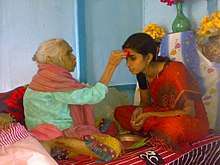
In Nepal, Vijayadashami follows the festival of Dashain. Youngsters visit the elders in their family, distant ones come to their native homes, and students visit their school teachers. The elders and teachers welcome the youngsters, mark their foreheads with tika and bless them. The family reveres the Hindu goddess of wealth Lakshmi, hoping for virtuous success and prosperity in the year ahead.[44][45]
See also
References
- Fuller, Christopher John (2004). The Camphor Flame: Popular Hinduism and Society in India. Princeton University Press. pp. 108–109. ISBN 978-0-69112-04-85.
- "National Portal of India". www.india.gov.in. Retrieved 18 December 2019.
- "National Portal of India". www.india.gov.in. Retrieved 3 August 2020.
- Encyclopedia Britannica 2015.
- James G. Lochtefeld 2002, pp. 212–213, 468–469.
- Encyclopedia Britannica Dussehra 2015.
- "Happy Dashain 2074". Lumbini Media. 18 September 2017. Retrieved 18 September 2017.
- James G. Lochtefeld 2002, p. 751.
- James G. Lochtefeld 2002, pp. 468–469.
- Gall, Susan B.; Natividad, Irene (1995). The Asian-American Almanac. Gale Research. p. 24. ISBN 978-0-8103-9193-2.
- Singh, Rina (2016). Diwali. Orca. pp. 17–18. ISBN 978-1-4598-1008-2.
- "Sanskrit Dictionary for Spoken Sanskrit". spokensanskrit.org. Retrieved 18 December 2019.
- "Sanskrit Dictionary for Spoken Sanskrit". spokensanskrit.org. Retrieved 18 December 2019.
- Constance Jones & James D. Ryan 2006, pp. 308-309.
- "Sanskrit Dictionary for Spoken Sanskrit". spokensanskrit.org. Retrieved 18 December 2019.
- "Sanskrit Dictionary for Spoken Sanskrit". spokensanskrit.org. Retrieved 18 December 2019.
- James G. Lochtefeld 2002, pp. 212-213.
- Krishna, Nanditha; M, Amirthalingam (2014). Sacred Plants of India (first ed.). Penguin books india 2014. pp. 171–175. ISBN 9780143066262.
- "Dussehra". 31 August 2018.
- "గాండీవం పట్టిన అర్జునుడు | TELUGU MAHABHARATAM EPISODE 78 | UNTOLD HISTORY TELUGU | UHT". Retrieved 18 December 2019 – via www.youtube.com.
- "The Mahabharata, Book 4: Virata Parva: Go-harana Parva: Section LXI". www.sacred-texts.com. Retrieved 19 January 2018.
- "The Mahabharata, Book 4: Virat Parva: Go-harana Parva: Section LIV". www.sacred-texts.com. Retrieved 19 January 2018.
- James G. Lochtefeld 2002, pp. 212–213.
- Ramlila, the traditional performance of the Ramayana, UNESCO
- Constance Jones & James D. Ryan 2006, pp. 308–309.
- Dutta, Sanjay (11 October 2008). "International Dussehra festival kicks-off at Kullu". The Indian Express. Retrieved 3 May 2016.
- James G. Lochtefeld 2002, p. 213.
- "Dussera or Vijayadahami – Why Do We Celebrate It?". 14 October 2013. Retrieved 3 April 2014.
- Fuller, Christopher John (2004). The Camphor Flame: Popular Hinduism and Society in India. Princeton University Press. pp. 117–119. ISBN 978-0-69112-04-85.
- Sivapriyananda, S (1995). Mysore Royal Dasara. Abhinav Publications. pp. 73–75.
- "Vijayadasami admissions on in schools despite instructions against mid-year intake". Retrieved 18 October 2018.
- https://www.india.com/travel/articles/dasara-2016-dussehra-celebration-in-maharashtra-3231817/
- Shirgaonkar, Varsha. ""Madhyayugin Mahanavami aani Dasara"." Chaturang, Loksatta (1996).
- Mehta, Jaswant Lal (2005). Advanced Study in the History of Modern India 1707-1813. Sterling Publishers Pvt. Ltd. pp. 505–509. ISBN 978-1-932705-54-6.
- Sabharwal, Gopa (2006). Ethnicity and Class: Social Divisions in an Indian City. Oxford University Press. pp. 123–125. ISBN 978-0-19-567830-7.
- "Dussehra celebrated with religious fervour". Times of India. 7 October 2011.
- Asuras? No, Just Indians, Outlook India
- Celebrating Ravan, The Hindu
- Thaker, Aruna; Barton, Arlene (2012). Multicultural Handbook of Food, Nutrition and Dietetics. John Wiley & Sons. p. 6. ISBN 978-1-4051-7358-2.
- Hillary Rodrigues 2003, pp. 244–245.
- June McDaniel 2004, pp. 168–169.
- Hillary Rodrigues 2003, pp. 66–67, 236–241, 246–247.
- Hillary Rodrigues 2003, pp. 67–68.
- Deep, Dhurba Krishna (1993). Popular Deities, Emblems & Images of Nepal. Nirala. pp. 50–51. ISBN 978-81-85693-25-5.
- Thapa, Netra Bahadur; Thapa, D. P. (1969). Geography of Nepal: Physical, Economic, Cultural & Regional. Orient Longmans. pp. 92–93.
Bibliography
- Amazzone, Laura (2012). Goddess Durga and Sacred Female Power. University Press of America. ISBN 9780761853145. Retrieved 5 February 2017.
- Coburn, Thomas B. (1991). Encountering the Goddess: A translation of the Devi-Mahatmya and a Study of Its Interpretation. State University of New York Press. ISBN 0791404463.
- Reid-Bowen, Paul (2012). Cush, Denise; Robinson, Catherine; York, Michael (eds.). Encyclopedia of Hinduism. Routledge. ISBN 978-1-135-18979-2.CS1 maint: ref=harv (link)
- Jones, Constance; Ryan, James D. (2006). Encyclopedia of Hinduism. Infobase Publishing. ISBN 978-0-8160-7564-5.CS1 maint: ref=harv (link)
- Kinsley, David (1988). Hindu Goddesses: Visions of the Divine Feminine in the Hindu Religious Tradition. University of California Press. ISBN 978-0-520-90883-3.
- Lochtefeld, James G. (2002). The Illustrated Encyclopedia of Hinduism: N–Z. The Rosen Publishing Group. ISBN 0-8239-2287-1.CS1 maint: ref=harv (link)
- McDaniel, June (2004). Offering Flowers, Feeding Skulls: Popular Goddess Worship in West Bengal. Oxford University Press. ISBN 978-0-19-534713-5.CS1 maint: ref=harv (link)
- McDermott, Rachel Fell (2001). Mother of My Heart, Daughter of My Dreams: Kali and Uma in the Devotional Poetry of Bengal. Oxford University Press. ISBN 978-0-19-803071-3.CS1 maint: ref=harv (link)
- Rocher, Ludo (1986). The Puranas. Otto Harrassowitz Verlag. ISBN 978-3447025225.
- Rodrigues, Hillary (2003). Ritual Worship of the Great Goddess: The Liturgy of the Durga Puja with Interpretations. SUNY Press. ISBN 978-0-7914-8844-7.CS1 maint: ref=harv (link)
- "Navratri – Hindu festival". Encyclopedia Britannica. 2017. Retrieved 21 February 2017.
- "Dussehra – Hindu festival". Encyclopedia Britannica. 2014. Retrieved 21 February 2017.
External links
| Wikimedia Commons has media related to Dasara. |
- Mysuru (Karnataka) Dasara Festival, Government of India
- Dussehra in Telangana, Government of India

